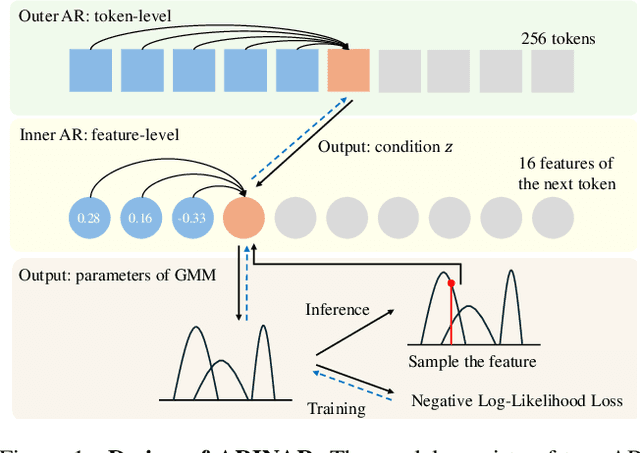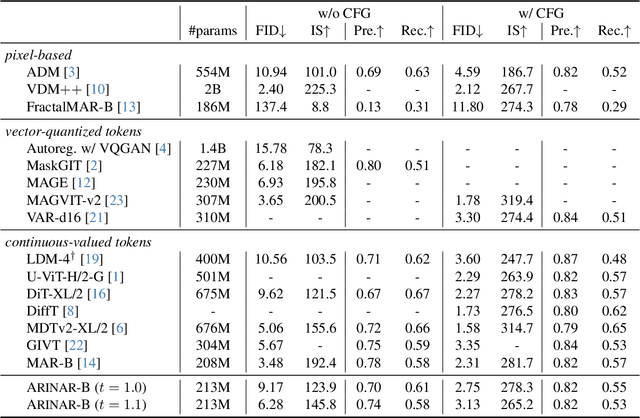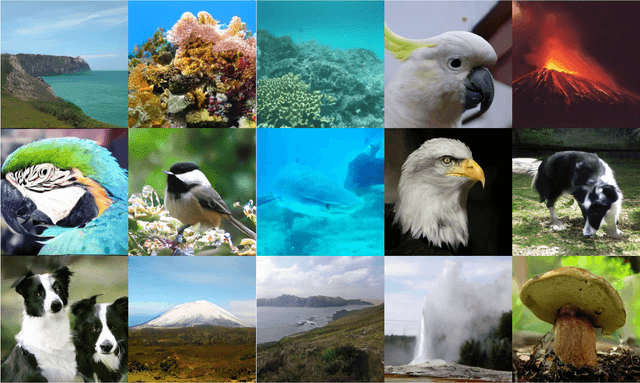Liang Zheng
Effective Training Data Synthesis for Improving MLLM Chart Understanding
Aug 08, 2025Abstract:Being able to effectively read scientific plots, or chart understanding, is a central part toward building effective agents for science. However, existing multimodal large language models (MLLMs), especially open-source ones, are still falling behind with a typical success rate of 30%-50% on challenging benchmarks. Previous studies on fine-tuning MLLMs with synthetic charts are often restricted by their inadequate similarity to the real charts, which could compromise model training and performance on complex real-world charts. In this study, we show that modularizing chart generation and diversifying visual details improves chart understanding capabilities. In particular, we design a five-step data synthesis pipeline, where we separate data and function creation for single plot generation, condition the generation of later subplots on earlier ones for multi-subplot figures, visually diversify the generated figures, filter out low quality data, and finally generate the question-answer (QA) pairs with GPT-4o. This approach allows us to streamline the generation of fine-tuning datasets and introduce the effective chart dataset (ECD), which contains 10k+ chart images and 300k+ QA pairs, covering 25 topics and featuring 250+ chart type combinations with high visual complexity. We show that ECD consistently improves the performance of various MLLMs on a range of real-world and synthetic test sets. Code, data and models are available at: https://github.com/yuweiyang-anu/ECD.
Vec2Face+ for Face Dataset Generation
Jul 23, 2025Abstract:When synthesizing identities as face recognition training data, it is generally believed that large inter-class separability and intra-class attribute variation are essential for synthesizing a quality dataset. % This belief is generally correct, and this is what we aim for. However, when increasing intra-class variation, existing methods overlook the necessity of maintaining intra-class identity consistency. % To address this and generate high-quality face training data, we propose Vec2Face+, a generative model that creates images directly from image features and allows for continuous and easy control of face identities and attributes. Using Vec2Face+, we obtain datasets with proper inter-class separability and intra-class variation and identity consistency using three strategies: 1) we sample vectors sufficiently different from others to generate well-separated identities; 2) we propose an AttrOP algorithm for increasing general attribute variations; 3) we propose LoRA-based pose control for generating images with profile head poses, which is more efficient and identity-preserving than AttrOP. % Our system generates VFace10K, a synthetic face dataset with 10K identities, which allows an FR model to achieve state-of-the-art accuracy on seven real-world test sets. Scaling the size to 4M and 12M images, the corresponding VFace100K and VFace300K datasets yield higher accuracy than the real-world training dataset, CASIA-WebFace, on five real-world test sets. This is the first time a synthetic dataset beats the CASIA-WebFace in average accuracy. In addition, we find that only 1 out of 11 synthetic datasets outperforms random guessing (\emph{i.e., 50\%}) in twin verification and that models trained with synthetic identities are more biased than those trained with real identities. Both are important aspects for future investigation.
DiSA: Diffusion Step Annealing in Autoregressive Image Generation
May 26, 2025Abstract:An increasing number of autoregressive models, such as MAR, FlowAR, xAR, and Harmon adopt diffusion sampling to improve the quality of image generation. However, this strategy leads to low inference efficiency, because it usually takes 50 to 100 steps for diffusion to sample a token. This paper explores how to effectively address this issue. Our key motivation is that as more tokens are generated during the autoregressive process, subsequent tokens follow more constrained distributions and are easier to sample. To intuitively explain, if a model has generated part of a dog, the remaining tokens must complete the dog and thus are more constrained. Empirical evidence supports our motivation: at later generation stages, the next tokens can be well predicted by a multilayer perceptron, exhibit low variance, and follow closer-to-straight-line denoising paths from noise to tokens. Based on our finding, we introduce diffusion step annealing (DiSA), a training-free method which gradually uses fewer diffusion steps as more tokens are generated, e.g., using 50 steps at the beginning and gradually decreasing to 5 steps at later stages. Because DiSA is derived from our finding specific to diffusion in autoregressive models, it is complementary to existing acceleration methods designed for diffusion alone. DiSA can be implemented in only a few lines of code on existing models, and albeit simple, achieves $5-10\times$ faster inference for MAR and Harmon and $1.4-2.5\times$ for FlowAR and xAR, while maintaining the generation quality.
REPA-E: Unlocking VAE for End-to-End Tuning with Latent Diffusion Transformers
Apr 14, 2025Abstract:In this paper we tackle a fundamental question: "Can we train latent diffusion models together with the variational auto-encoder (VAE) tokenizer in an end-to-end manner?" Traditional deep-learning wisdom dictates that end-to-end training is often preferable when possible. However, for latent diffusion transformers, it is observed that end-to-end training both VAE and diffusion-model using standard diffusion-loss is ineffective, even causing a degradation in final performance. We show that while diffusion loss is ineffective, end-to-end training can be unlocked through the representation-alignment (REPA) loss -- allowing both VAE and diffusion model to be jointly tuned during the training process. Despite its simplicity, the proposed training recipe (REPA-E) shows remarkable performance; speeding up diffusion model training by over 17x and 45x over REPA and vanilla training recipes, respectively. Interestingly, we observe that end-to-end tuning with REPA-E also improves the VAE itself; leading to improved latent space structure and downstream generation performance. In terms of final performance, our approach sets a new state-of-the-art; achieving FID of 1.26 and 1.83 with and without classifier-free guidance on ImageNet 256 x 256. Code is available at https://end2end-diffusion.github.io.
R2E-Gym: Procedural Environments and Hybrid Verifiers for Scaling Open-Weights SWE Agents
Apr 09, 2025Abstract:Improving open-source models on real-world SWE tasks (solving GITHUB issues) faces two key challenges: 1) scalable curation of execution environments to train these models, and, 2) optimal scaling of test-time compute. We introduce AgentGym, the largest procedurally-curated executable gym environment for training real-world SWE-agents, consisting of more than 8.7K tasks. AgentGym is powered by two main contributions: 1) SYNGEN: a synthetic data curation recipe that enables scalable curation of executable environments using test-generation and back-translation directly from commits, thereby reducing reliance on human-written issues or unit tests. We show that this enables more scalable training leading to pass@1 performance of 34.4% on SWE-Bench Verified benchmark with our 32B model. 2) Hybrid Test-time Scaling: we provide an in-depth analysis of two test-time scaling axes; execution-based and execution-free verifiers, demonstrating that they exhibit complementary strengths and limitations. Test-based verifiers suffer from low distinguishability, while execution-free verifiers are biased and often rely on stylistic features. Surprisingly, we find that while each approach individually saturates around 42-43%, significantly higher gains can be obtained by leveraging their complementary strengths. Overall, our approach achieves 51% on the SWE-Bench Verified benchmark, reflecting a new state-of-the-art for open-weight SWE-agents and for the first time showing competitive performance with proprietary models such as o1, o1-preview and sonnet-3.5-v2 (with tools). We will open-source our environments, models, and agent trajectories.
ARINAR: Bi-Level Autoregressive Feature-by-Feature Generative Models
Mar 04, 2025



Abstract:Existing autoregressive (AR) image generative models use a token-by-token generation schema. That is, they predict a per-token probability distribution and sample the next token from that distribution. The main challenge is how to model the complex distribution of high-dimensional tokens. Previous methods either are too simplistic to fit the distribution or result in slow generation speed. Instead of fitting the distribution of the whole tokens, we explore using a AR model to generate each token in a feature-by-feature way, i.e., taking the generated features as input and generating the next feature. Based on that, we propose ARINAR (AR-in-AR), a bi-level AR model. The outer AR layer take previous tokens as input, predicts a condition vector z for the next token. The inner layer, conditional on z, generates features of the next token autoregressively. In this way, the inner layer only needs to model the distribution of a single feature, for example, using a simple Gaussian Mixture Model. On the ImageNet 256x256 image generation task, ARINAR-B with 213M parameters achieves an FID of 2.75, which is comparable to the state-of-the-art MAR-B model (FID=2.31), while five times faster than the latter.
Think on your feet: Seamless Transition between Human-like Locomotion in Response to Changing Commands
Feb 26, 2025



Abstract:While it is relatively easier to train humanoid robots to mimic specific locomotion skills, it is more challenging to learn from various motions and adhere to continuously changing commands. These robots must accurately track motion instructions, seamlessly transition between a variety of movements, and master intermediate motions not present in their reference data. In this work, we propose a novel approach that integrates human-like motion transfer with precise velocity tracking by a series of improvements to classical imitation learning. To enhance generalization, we employ the Wasserstein divergence criterion (WGAN-div). Furthermore, a Hybrid Internal Model provides structured estimates of hidden states and velocity to enhance mobile stability and environment adaptability, while a curiosity bonus fosters exploration. Our comprehensive method promises highly human-like locomotion that adapts to varying velocity requirements, direct generalization to unseen motions and multitasking, as well as zero-shot transfer to the simulator and the real world across different terrains. These advancements are validated through simulations across various robot models and extensive real-world experiments.
Learning Camera Movement Control from Real-World Drone Videos
Dec 12, 2024



Abstract:This study seeks to automate camera movement control for filming existing subjects into attractive videos, contrasting with the creation of non-existent content by directly generating the pixels. We select drone videos as our test case due to their rich and challenging motion patterns, distinctive viewing angles, and precise controls. Existing AI videography methods struggle with limited appearance diversity in simulation training, high costs of recording expert operations, and difficulties in designing heuristic-based goals to cover all scenarios. To avoid these issues, we propose a scalable method that involves collecting real-world training data to improve diversity, extracting camera trajectories automatically to minimize annotation costs, and training an effective architecture that does not rely on heuristics. Specifically, we collect 99k high-quality trajectories by running 3D reconstruction on online videos, connecting camera poses from consecutive frames to formulate 3D camera paths, and using Kalman filter to identify and remove low-quality data. Moreover, we introduce DVGFormer, an auto-regressive transformer that leverages the camera path and images from all past frames to predict camera movement in the next frame. We evaluate our system across 38 synthetic natural scenes and 7 real city 3D scans. We show that our system effectively learns to perform challenging camera movements such as navigating through obstacles, maintaining low altitude to increase perceived speed, and orbiting towers and buildings, which are very useful for recording high-quality videos. Data and code are available at dvgformer.github.io.
Negative Token Merging: Image-based Adversarial Feature Guidance
Dec 02, 2024



Abstract:Text-based adversarial guidance using a negative prompt has emerged as a widely adopted approach to push the output features away from undesired concepts. While useful, performing adversarial guidance using text alone can be insufficient to capture complex visual concepts and avoid undesired visual elements like copyrighted characters. In this paper, for the first time we explore an alternate modality in this direction by performing adversarial guidance directly using visual features from a reference image or other images in a batch. In particular, we introduce negative token merging (NegToMe), a simple but effective training-free approach which performs adversarial guidance by selectively pushing apart matching semantic features (between reference and output generation) during the reverse diffusion process. When used w.r.t. other images in the same batch, we observe that NegToMe significantly increases output diversity (racial, gender, visual) without sacrificing output image quality. Similarly, when used w.r.t. a reference copyrighted asset, NegToMe helps reduce visual similarity with copyrighted content by 34.57%. NegToMe is simple to implement using just few-lines of code, uses only marginally higher (<4%) inference times and generalizes to different diffusion architectures like Flux, which do not natively support the use of a separate negative prompt. Code is available at https://negtome.github.io
Can We Predict Performance of Large Models across Vision-Language Tasks?
Oct 14, 2024



Abstract:Evaluating large vision-language models (LVLMs) is very expensive, due to the high computational costs and the wide variety of tasks. The good news is that if we already have some observed performance scores, we may be able to infer unknown ones. In this study, we propose a new framework for predicting unknown performance scores based on observed ones from other LVLMs or tasks. We first formulate the performance prediction as a matrix completion task. Specifically, we construct a sparse performance matrix $\boldsymbol{R}$, where each entry $R_{mn}$ represents the performance score of the $m$-th model on the $n$-th dataset. By applying probabilistic matrix factorization (PMF) with Markov chain Monte Carlo (MCMC), we can complete the performance matrix, that is, predict unknown scores. Additionally, we estimate the uncertainty of performance prediction based on MCMC. Practitioners can evaluate their models on untested tasks with higher uncertainty first, quickly reducing errors in performance prediction. We further introduce several improvements to enhance PMF for scenarios with sparse observed performance scores. In experiments, we systematically evaluate 108 LVLMs on 176 datasets from 36 benchmarks, constructing training and testing sets for validating our framework. Our experiments demonstrate the accuracy of PMF in predicting unknown scores, the reliability of uncertainty estimates in ordering evaluations, and the effectiveness of our enhancements for handling sparse data.
 Add to Chrome
Add to Chrome Add to Firefox
Add to Firefox Add to Edge
Add to Edge